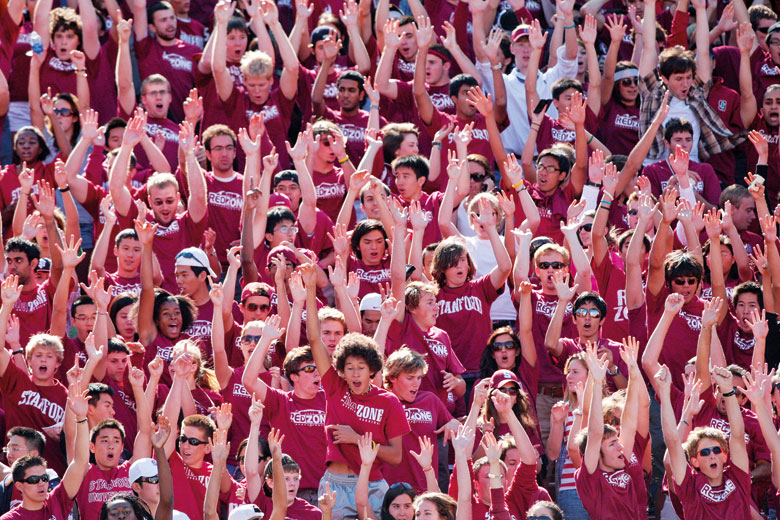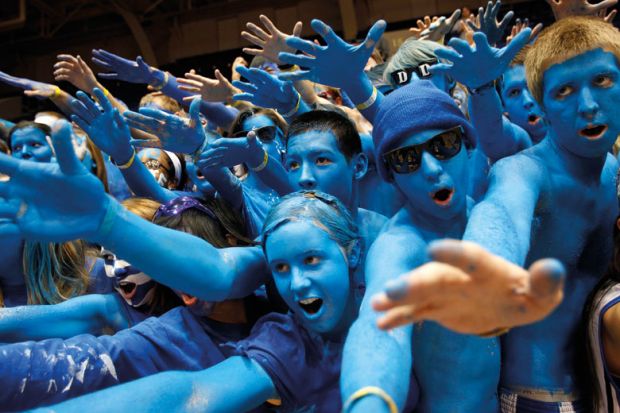View the full Wall Street Journal/Times Higher Education College Rankings results
At Williams College in Massachusetts there is a sculpture of two men sitting on a log, deep in conversation. One is Mark Hopkins, who led the liberal arts college for 36 years in the mid-19th century. The other is one of his students. According to Williams’ current president, Adam Falk, the sculpture symbolises the close interaction that has existed between scholars and their pupils since the college was founded in 1793.
“The idea is that’s all a college really is – faculty and students – and the rest is really there just to support that,” he says.
According to Falk, the college’s commitment to providing the best possible learning environment is epitomised by its student-to-staff ratio of just six to one, meaning that “most of the classes are small”.
Perhaps, then, it is no surprise to see Williams riding high in the inaugural Wall Street Journal/Times Higher Education College Rankings, which was published in the Wall Street Journal at the end of September. Unlike Times Higher Education’s World University Rankings, the 1,000-strong list of the top universities and colleges in the US does not focus primarily on research performance. Rather, it is based on four broad “pillars” that focus primarily on what the institutions offer students.
The first pillar is resources, which takes into account finance and faculty per student, as well as research papers per faculty member. The next is outcomes, which takes in academic reputation, graduation rate and the extent to which graduates earn more and repay more loan debt than would be expected given their socio-economic background. The environment pillar looks at the proportion of international students, as well as staff and student diversity. Finally, the engagement pillar looks at the quality of staff-student interaction, and draws on a survey of 100,000 US students carried out by THE.
At 22nd, Williams is the highest ranked liberal arts college. Most of the places above it are filled by a familiar roll call of globally renowned, research-intensive private universities: the top five is made up of Stanford University, the Massachusetts Institute of Technology, Columbia University, the University of Pennsylvania and Yale University. This is largely because such institutions are very wealthy and boast outstanding outcomes for students in terms of graduation rates and value-added salaries; between them, resources (30 per cent) and outcomes (40 per cent) make up 70 per cent of the total marks in the rankings.
But a different picture emerges when institutions are ranked solely by the engagement pillar (table, below), which counts for 20 per cent overall. Specific metrics within this pillar include whether teaching is challenging, supports critical thinking skills and enables students to apply their learning to the real world, as well as the level of interaction between students and faculty, opportunities for collaborative learning and whether students would recommend their institution to a friend.
The engagement pillar is headed by five Christian institutions. Top of the pile is Dordt College in Iowa. Erik Hoekstra, the institution’s president, says that Dordt freshmen rank in the 77th percentile nationally in the ETS Proficiency Profile: a standardised testing system that measures students’ performance in critical thinking, reading, writing and mathematics. By the third year, they rank in the 96th percentile.
WSJ/THE College Rankings 2017: top 20 colleges for engagement
| Rank | Overall rank | Institution name | Engagement score |
| 1 | 419 | Dordt College | 18.3 |
| =2 | 104 | Brigham Young University-Provo | 18.0 |
| =2 | 196 | Texas Christian University | 18.0 |
| 4 | 372 | Cedarville University | 17.9 |
| 5 | 186 | Baylor University | 17.8 |
| =6 | 273 | Auburn University | 17.7 |
| =6 | 601-800 | Bowling Green State University | 17.7 |
| =6 | 157 | Bradley University | 17.7 |
| =6 | 601-800 | University of Central Oklahoma | 17.7 |
| =6 | 321 | Miami University | 17.7 |
| =6 | 63 | Michigan State University | 17.7 |
| =6 | 34 | Swarthmore College | 17.7 |
| =13 | 221 | California Polytechnic State University, San Luis Obispo | 17.6 |
| =13 | 295 | Cedar Crest College | 17.6 |
| =13 | 334 | University of Cincinnati-Uptown | 17.6 |
| =13 | 287 | Concordia College at Moorhead | 17.6 |
| =13 | 194 | Ithaca College | 17.6 |
| =13 | 501-600 | North Carolina Agricultural and Technical State University | 17.6 |
| =13 | 492 | Ohio University | 17.6 |
| =13 | 4 | University of Pennsylvania | 17.6 |
| =13 | 360 | Taylor University | 17.6 |
| =13 | 80 | Texas A&M University-College Station | 17.6 |
He attributes this growth in part to the fact that the college’s 1,586 undergraduates live on campus for all four years of their degree, forming a “tight-knit community where conversations about things like critical thinking extend beyond the classrooms and go into the dormitories in weekends and evenings. Students spend more time thinking and talking and processing the deep ideas that they first approach in the classroom and naturally it leads to more growth.” Sofas and benches outside professors’ offices also promote staff-student interaction, he adds.
The rest of the top 20 for engagement is made up of a wide variety of institutions, from large public universities, such as Michigan State University, to secular liberal arts colleges. Swarthmore College, in Pennsylvania, is the top-ranked among the latter at joint 6th; Williams, interestingly, only ranks joint 455th.
Research-intensive universities tend to score relatively poorly on engagement. Their students are least likely to rate them highly for interaction with staff and collaborative learning with their peers, or for providing an engaging learning environment. Take the California Institute of Technology, which was the top institution in the THE World University Rankings between 2012 and 2015 and is 10th overall in our College Rankings. Despite the fact that it only has just over 1,000 undergraduates and a student-to-staff ratio of 3:1, it ranks in the 801+ bracket for engagement. Nor is its underperformance in that area unique: only eight of the top 20 overall institutions are inside the top 100 for engagement, with Harvard and Princeton University languishing in the 601-800 bracket, for instance.
When examined specifically on whether their students would recommend them to family and friends, the top institutions fare little better. Only two of the top 20 overall institutions are ranked in the top 100: Stanford at number seven and Rice University at 32. Harvard ranks only in the 601-800 bracket and Princeton is joint 499th, while Caltech is again in the 801+ bracket. The institution that is most enthusiastically recommended by its students is The Master’s University, a Christian liberal arts university in Santa Clarita, California, followed by the State University of New York College of Environmental Science and Forestry in Syracuse. Dordt comes third.
In the student survey, Harvard students express a desire for “more collaborative work and skill-building” activities and “more open conversations [between] faculty and students” at the institution. One student comments that “because it’s a research university, sometimes professors’ actual teaching skills come second, and, at times, it shows”. Another says: “Engagement between the administration and student body is absolutely horrific. It’s as if Harvard is putting its public image and brand before its students’ social and emotional welfare.”
Meanwhile, one Princeton student, when asked whether the university could improve any aspects of the student experience, highlights the Ivy League institution’s “approach towards accommodating the requests of its students”. Another cited the “relationships between students and academic advisers”.
However, problems with student engagement are not just confined to the country’s top private universities. The University of Michigan-Ann Arbor is the top public university in the overall College Rankings, at 24th, and ranks joint 31st on overall engagement and joint 92nd on student recommendation. However, it is only in the 801+ bracket when ranked by students’ interaction with staff and opportunities for collaborative learning with peers. The second-highest performing public university overall, the University of California, Los Angeles (UCLA), ranked 26th, is only joint 213th for overall engagement and is also in the 801+ range for interaction and collaborative learning. This could be due to such institutions’ focus on research; the data show that universities that produce more research papers per faculty are less likely to have high scores on interaction and collaborative learning.
WSJ/THE College Rankings 2017: top 20 colleges for resources
| Rank | Overall rank | Institution name | Resources score |
| 1 | 6 | Harvard University | 29.9 |
| 2 | 10 | California Institute of Technology | 29.4 |
| 3 | 2 | Massachusetts Institute of Technology | 29.3 |
| 4 | 8 | Princeton University | 28.3 |
| 5 | 18 | Rice University | 27.4 |
| =6 | =13 | Northwestern University | 27.3 |
| =6 | 1 | Stanford University | 27.3 |
| 8 | 4 | University of Pennsylvania | 27.2 |
| =9 | 20 | Brown University | 27.1 |
| =9 | 3 | Columbia University | 27.1 |
| =9 | 9 | Cornell University | 27.1 |
| 12 | =13 | University of Chicago | 27.0 |
| =13 | 7 | Duke University | 26.8 |
| =13 | 5 | Yale University | 26.8 |
| 15 | 16 | Dartmouth College | 26.7 |
| 16 | =11 | Johns Hopkins University | 26.6 |
| =17 | 27 | Tufts University | 26.4 |
| =17 | =11 | Washington University in St Louis | 26.4 |
| 19 | 17 | Emory University | 26.1 |
| 20 | 19 | Carnegie Mellon University | 25.9 |
Nevertheless, Michigan president Mark Schlissel says there are “special advantages” for students who are educated at research universities. “The faculty are the same scholars that are asking questions and defining what the edges of human knowledge and understanding are. That provides students with a different kind of educational experience,” he says.
“One of the things I noted when I first came here was that faculty tend to use the same kind of creativity in their research [and] in their teaching,” he adds – although he admits that this is “a little bit unusual among research universities”.
UCLA chancellor Gene Block also insists that the university takes all three parts of its mission, of which outstanding education is one, “extremely seriously”.
“If you look at a college like Swarthmore, they have a relatively small number of students and that obviously provides a special experience,” he says. “We’re kind of wholesale in that sense – we have a much larger number of students – and our goal has been to make that wholesale experience retail in every way we can.”
He says that this has included arranging small freshmen seminars of no more than 20 students.
But Duncan Ross, THE’s director of data and analytics, says that larger universities, in particular, “find it difficult to maintain the same level of engagement with students as the smaller schools”. And he says there is “no doubt” that at research universities “there is a risk that teaching [plays] second fiddle. You see this very much in how academics are promoted and what is seen as being important within the institutions themselves.”
But he adds that this could be challenged somewhat by the student-oriented College Scorecard database. Launched during the Obama administration, this includes a range of information about individual higher education institutions, including tuition fees, graduation rates and graduate salaries.
“There’s always a case for putting more information in the hands of both university management – to help them understand how they can improve their performance – and students and prospective students – so they can make more informed choices,” he says.
The top institutions for interaction and collaborative learning are mostly small colleges, headed by Alverno College, a Catholic women’s college in Milwaukee.
Brandon Busteed, executive director for education and workforce development at polling and consulting company Gallup, says that a survey of US college graduates published last year also found that student engagement was an issue at the US’ research universities. Of the 30,000 respondents to the Gallup-Purdue Index, only 27 per cent strongly agreed that their professor cared about them as a person, Busteed says, adding that this figure is even lower when only answers from graduates of research universities are counted.
“There has clearly been more emphasis on research than teaching,” he observes – although he adds that “these things don’t have to be mutually exclusive”.
That last point is demonstrated by the fact that Michigan is not alone among research intensives in ranking highly on the overall engagement pillar. The University of Pennsylvania is joint 13th, for instance, while Stanford is joint 31st and Brown and Cornell universities are joint 39th.
The College Rankings suggest that there are clear incentives for institutions to provide an outstanding experience for students. Institutions that score best on the specific engagement metric are also more likely to have better graduation rates, while students that are engaged are more likely to recommend their college to a friend.
WSJ/THE College Rankings 2017: top 20 colleges for outcome
| Rank | Overall rank | Institution name | Outcome score |
| 1 | 5 | Yale University | 39.5 |
| =2 | 8 | Princeton University | 39.4 |
| =2 | 1 | Stanford University | 39.4 |
| =4 | 3 | Columbia University | 39.3 |
| =4 | 7 | Duke University | 39.3 |
| =6 | 10 | California Institute of Technology | 39.2 |
| =6 | 2 | Massachusetts Institute of Technology | 39.2 |
| 8 | =13 | University of Chicago | 39.1 |
| 9 | 4 | University of Pennsylvania | 39.0 |
| 10 | 21 | Vanderbilt University | 38.8 |
| 11 | =11 | Johns Hopkins University | 38.7 |
| =12 | 16 | Dartmouth College | 38.6 |
| =12 | =11 | Washington University in St Louis | 38.6 |
| 14 | 6 | Harvard University | 38.4 |
| =15 | 9 | Cornell University | 38.2 |
| =15 | 24 | University of Michigan-Ann Arbor | 38.2 |
| 17 | 15 | University of Southern California | 38.0 |
| 18 | =13 | Northwestern University | 37.8 |
| =19 | 17 | Emory University | 37.7 |
| =19 | 22 | Williams College | 37.7 |
Mark Wrighton, chancellor of the private Washington University in St Louis, which is joint 11th overall and joint 23rd when judged only on the overall engagement pillar, says that despite his institution’s research mission, it has a “student-first approach”, centred around recruiting both the most talented students it can and “very strong faculty and professional staff, who are devoted to the student experience”.
He adds that the university gives 1 per cent of its tuition revenue to student leaders to distribute to student organisations. This enables those leaders to “develop an understanding of budgeting and setting priorities and gives them an opportunity to use resources to advance the student experience”.
An area where both research-intensive universities and liberal arts colleges generally underperform is student diversity and inclusion. This measures the breadth of a university’s student population with regard to their ethnic and socioeconomic background. The data show that the richest universities tend to be the worst at recruiting students from disadvantaged backgrounds, while the more inclusive an institution, the worse its graduation rates are likely to be.
Busteed says that his study showed that black graduates from historically black colleges are more than twice as likely to report that they had a supportive learning environment than black graduates from any other type of university. In addition, graduates who strongly agreed that they had interacted with people from a variety of backgrounds on a regular basis are more than twice as likely to strongly agree that their education was worth the cost, Busteed adds.
Williams College’s Falk agrees that the main challenge for his institution in the future will be to ensure that students from disadvantaged backgrounds can thrive there.
“The relevance of higher education in the US in this century will be directly related to our ability to successfully educate and integrate into our communities people from a much wider variety of our society than we have in the past,” he says.
THE’s Ross says it is “very hard to draw conclusive causal inferences” from the data on student inclusion and diversity, but one of the clear findings is that public universities have particularly diverse student bodies. “Quite rightly, they see a significant part of their role to be responding to their local communities, and there is representation in [their student cohorts] for minority groups that traditionally might not have been included,” he says.
Three Hawaiian universities – Chaminade University of Honolulu, University of Hawai‘i at Hilo and Hawaii Pacific University – are top for student diversity, which looks at the likelihood of two undergraduate students being from different ethnic groups. Meanwhile, three California State University campuses – Los Angeles, San Bernardino and Bakersfield – are top for student inclusion, which examines the proportion of Pell Grants (paid to students in need of financial support) and first-generation students. Among research-intensives, Stanford is the top performer on diversity, at joint 13th. UCLA is 37th for student diversity, but only 357th for inclusion. (All the overall top 20 institutions are in the 801+ bracket for inclusion.) It is 10th on the environment pillar overall, which also takes into account staff diversity and proportion of international students (Californian and New York institutions dominate the top 15 places). Block says that, this year, 19 per cent of the incoming students at the university are Latino, 5 per cent are African American, 29 per cent are Caucasian and 41 per cent are Asian American, adding that the racial mix is “starting to look a lot like LA”.
WSJ/THE College Rankings 2017: top 20 colleges for environment
| Rank | Overall rank | Institution name | Environment score |
| 1 | 601-800 | La Sierra University | 9.4 |
| 2 | 305 | CUNY City College of New York | 9.3 |
| =3 | 601-800 | California State University, Northridge | 9.2 |
| =3 | 601-800 | Johnson & Wales University-North Miami | 9.2 |
| =3 | 601-800 | San Francisco State University | 9.2 |
| =6 | 290 | CUNY Bernard M. Baruch College | 9.1 |
| =6 | 601-800 | California State University, East Bay | 9.1 |
| =8 | 487 | Barry University | 9.0 |
| =8 | 153 | University of California, Irvine | 9.0 |
| 10 | 26 | University of California, Los Angeles | 8.9 |
| =11 | 453 | California State University, Long Beach | 8.8 |
| =11 | 801+ | University of Houston-Downtown | 8.8 |
| =13 | 350 | CUNY Hunter College | 8.7 |
| =13 | 601-800 | CUNY York College | 8.7 |
| =13 | 601-800 | California State University, San Bernardino | 8.7 |
| =13 | 501-600 | Hawaii Pacific University | 8.7 |
| =17 | 501-600 | California State Polytechnic University, Pomona | 8.6 |
| =17 | 49 | University of California, San Diego | 8.6 |
| =17 | 501-600 | University of Hawai‘i at Hilo | 8.6 |
| =17 | 801+ | Nyack College | 8.6 |
| =17 | 501-600 | San Jose State University | 8.6 |
He adds that having a diverse student community is “critical” to “prepare young people today to live in a global environment”. It also creates a vibrant classroom experience “because of the different perspectives it brings”.
However, Ronald Ehrenberg, professor of industrial and labour relations and economics at Cornell University and author of the 2007 book What’s Happening to Public Higher Education?, says he is “very concerned” that state funding cuts to public universities, which have occurred since the late 1980s, will lead to a “bifurcated educational system where the people [that] need the most resources are getting the least”.
“The real [issue] for the US economy is that we desperately need to enhance the fraction of the population that has college degrees. And the groups that are underrepresented in higher education, which tend to be people from low-income families and people from racial minorities, disproportionately wind up at the public institutions, which are the least well-funded institutions,” he says. In that regard, it is significant to note that there is a negative relationship between inclusiveness and almost all the metrics in the rankings, including student engagement, student recommendation, student interaction with staff and collaborative learning, academic reputation and value-added salaries.
Ehrenberg adds that public universities’ financial difficulties put educational resources and student services at particular risk since although such institutions “try desperately to cut elsewhere, when push comes to shove, typically faculty are the last to go, so student services are not [as well] protected”.
He says there has also been a public shift “away from the notion of public higher education as a good for everyone” and a “focus on the fact that people are going to college to get higher paying jobs. If that’s the case [the public feel that students] and their families should pay for it, rather than the taxpayer in general,” he says.
Returning to the topic of student engagement, he says it is “absolutely essential” that universities improve in this area because “the goal of higher education is to create people who are thinkers and lifelong learners, and [students] will only [become] this if they are in environments where they are engaged and learning”.
Chris Newfield, professor of literature and American studies at the University of California, Santa Barbara, says that most students “want to develop as people” and “want to get something in addition to a job that pays well and has some satisfaction” from their college degree.
“This is about learning cognitive skills,” says Newfield, who has written a forthcoming book, The Great Mistake, exploring the post-2008 struggles of public universities to rebuild their social missions. If the sole purpose of higher education institutions is “job training” then “we don’t need universities”, he believes.
The “real problem” around student engagement at research-intensive institutions is that universities have not been up front about the “real costs of running a research university”, he says.
“Unless you move towards a system where the costs of research are fully funded, the quality of instruction at research universities is never going to get to where it should be. That involves us being honest about the losses we’re making on [research], what it really costs, and what the educational needs are of students.”
View the Wall Street Journal/Times Higher Education College Rankings methodology

How Stanford University keeps its students engaged
How does a world-leading research university produce an engaging teaching environment? Harry Elam, vice-provost for undergraduate education at Stanford University, attributes its strength in student engagement to a “pledge” the institution made to “bring our world-class faculty and our amazing students together” in an “intimate” and “intellectual” way.
He says that the university conducted a study of undergraduate education in 2012, which led to the adoption of four basic principles. The first calls for students to graduate with “embodied” knowledge that they will retain and actively use, as opposed to memorised, superficially grasped knowledge geared to passing exams. Other principles say students should acquire a variety of skills learned in different contexts, personal and social responsibility and the ability to apply their learning to new environments.
Elam says this commitment can be seen in a range of special classes for students. One of these is a series of small introductory seminars for first- and second-year undergraduates in which the most esteemed professors talk about their main research interests.
“Students have to apply to get into that particular seminar, so they have an investment in being there, and the professors have a real engagement in terms of teaching them,” he says.
The university also offers a three-week Sophomore College course for students beginning their second year, he says, which gives them a “real chance to think critically about a subject”. He adds that classes are capped at 12, with participants living together, going on field trips or group activities most afternoons and summarising their learning in a concluding symposium.
Stanford also runs programmes in New York City and Washington DC for which students undertake an internship with a company during the day and attend classes in the evening. Elam says this is designed to help them apply their learning to real-life situations.
But Stanford does not only focus on providing top-quality teaching. Elam says the university also gives departments a total of $5 million (£3.8 million) a year to fund 1,000 undergraduates to conduct their own research, often working alongside an academic on a specific project.
Ellie Bothwell
Editor’s note: 16 June 2017
The information on this page was correct at the time of publication. Since then, Times Higher Education has reissued the US College Rankings. For the most up-to-date 2017 US College Rankings results, always use the overall league table. Click here for more information.
POSTSCRIPT:
Print headline: Schools of engagement
Register to continue
Why register?
- Registration is free and only takes a moment
- Once registered, you can read 3 articles a month
- Sign up for our newsletter
Subscribe
Or subscribe for unlimited access to:
- Unlimited access to news, views, insights & reviews
- Digital editions
- Digital access to THE’s university and college rankings analysis
Already registered or a current subscriber? Login





